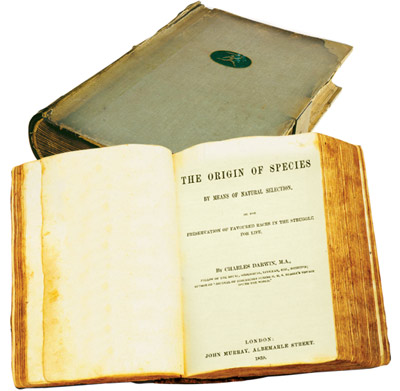Darwinism claims that all living things on Earth came into being not through any purpose or plan, but as a result of random events. The first link in this chain of events is that the first living thing appeared within inanimate matter. To discuss whether or not there is a natural process of evolution, first it must be demonstrated that life could actually have arisen by chance from inanimate matter.
So, when we compare this "link" with scientific data, what comes to light? That is, can chance form a living organism from inanimate matter?
Once, it was thought that observation and experiment gave an affirmative answer to the above questions. That is, it was believed that living creatures could evolve spontaneously within inanimate matter. But these observations and experiments that seemed to prove those assertions were extremely primitive.
 |
The ancient Egyptians living along the River Nile thought that the number of frogs increased during the rainy season because the river generated them out of the mud. They believed that not only frogs, but snakes, worms and mice were formed from the mud when the Nile flooded each summer. Superficial observations led the Egyptians into this superstition.
The boundary between animate and inanimate things was unclear not only in ancient Egypt. Many early pagan societies believed that this boundary could be easily crossed. In Hindu mythology, the world came into being out of a huge, round blob of matter called prakriti. From this material, all animate and inanimate things evolved and will return to it again. Anaximander, the ancient Greek philosopher Thales' pupil, wrote in his book On Nature that animals came to be from some mud steaming in the heat of the Sun.
 |
| Lazzaro Spallanzani |
The basis of all these superstitions was the belief that living things were simple structures. This belief was long maintained in Europe, where modern science began to develop in the 16th century. But the idea that the structure of life was simple held sway for at least another three hundred years, because scientists did not have the means to observe the minute details of living things, especially microscopic cells and tiny molecules.
A few superficial observations and experiments convinced scientists that life was simple. For example, the Belgian chemist Jan Baptista van Helmont (1577-1644), spread some wheat on a soiled shirt and, after a while, observed mice scurrying around the shirt. He concluded that the mice were produced from the combination of the wheat and the shirt. The German scientist Athanasius Kircher (1601-1680) did a similar experiment. He poured some honey over some dead flies and later saw other flies were zooming around the honey; he assumed that combining honey with dead flies produced living ones.
More careful scientists were able to see that all these ideas were wrong. The Italian scientist Francisco Redi (1626-1697) was the first to do controlled experiments in this regard. Using the isolation method, he discovered that maggots on meat did not come into being spontaneously, but developed from eggs deposited by flies. Redi proved that life could not come from inanimate matter, but only from other life—a view that came to be known as biogenesis. The name given to the spontaneous generation of life was abiogenesis.
The scientific argument between supporters of biogenesis and abiogenesis was continued into the 18th century by John Needham (1713-1781) and Lazzaro Spallanzani (1729-1799). Each of them boiled a piece of meat, then isolated it. Needham observed that maggots appeared on the meat and took this as proof for abiogenesis. Spallanzani repeated the same experiment, but boiled the meat for a longer time. In this way, all organic life forms on the meat were destroyed and as a result, no maggots appeared on it. So even though Spallanzani had invalidated the theory of abiogenesis, many people did not believe him; saying that Spallanzani had boiled the meat so long that he killed the "vital power" within it.
 |
| Louis Pasteur's scientific experiments demolished the dogma that life could be born out of inanimate matter. Thus the very first link in the illusory evolutionary chain that Darwinism proposed came to a dead end. |
As Charles Darwin was developing his theory, the question of the origins of life was obfuscated by debates like these. Many people believed that inanimate matter could generate bacteria and other germs, if not visible creatures like maggots. In 1860, the famous French chemist Louis Pasteur disproved the age-old assertions of abiogenesis, though it continued to hold its place in the minds of many.
Darwin almost never considered how the first cell came into being. He never mentions this subject in his book The Origin of Species published in 1859. Even after Pasteur's experiments posed a major problem for him in this regard, he hardly dealt with the topic. His only explanation for the origin of life was that the first cell could have come into being in a "warm little pond."
In a letter to Joseph Hooker in 1871, Darwin wrote:
It is often said that all the conditions for the first production of a living organism are now present, which could ever have been present. But if we could conceive in some warm little pond, with all sorts of ammonia and phosphoric salts, light, heat, electricity, etc., present, that a protein compound was chemically formed ready to undergo still more complex changes, at the present day such matter would be instantly devoured or absorbed, which would not have been the case before living creatures were formed.7
 |
| Darwin's book, The Origin of Species |
In short, Darwin maintained that if a small, warm pond contained the chemical raw materials for life, they could form proteins which could then multiply, and combine to form a cell. Moreover, he asserted that such a formation was impossible under present world conditions, but could have occurred in an earlier period.
Both of Darwin's claims are pure speculation, without scientific foundation.
But they would inspire those evolutionists who came after him and launch them on a fruitless labor that would last for more than a century.
This hopeless effort rested on an error defended for centuries, and which also misled Darwin, that life is of pure chance and natural law.
Since that time, more than a century has passed, and thousands of scientists have tried to explain the origins of life in terms of evolution. Two scientists who cleared a new path in this search were Alexander Oparin and J.B.S. Haldane—one Russian, the other English, but both Marxists. They advanced the theory known as "chemical evolution," and proposed, as Darwin had dreamed of doing, that molecules—the raw material of life—could, with the addition of energy, evolve spontaneously and form a living cell.
In the middle of the 20th century, Oparin's and Haldane's theory gained ground because the true complexity of life wasn't yet understood. And a young chemist by the name of Stanley Miller gave apparent scientific support for the "chemical evolution" thesis.
 | |
| J. B. S. Haldane | Alexander Oparin |
 |
| Stanley Miller |
If you were to look at today's evolutionist literature dealing with the origins of life, you would likely see evolution's proponents offering the "Miller experiment" as the greatest proof for their theses. Many biology textbooks in many countries tell students how important this experiment was, and how it cast light on the problem of the origins of life. Most often, the details of the experiment are disregarded. What it produced and to what extent the experiment "casts light" on the origins of life are also ignored.
To shed some light on this experiment, let us sum up the relevant facts that we have detailed in another book. In 1953, Stanley Miller, a graduate student in the Department of Chemistry at the University of Chicago under the supervision of his teacher, Harold Urey, composed a mixture of gasses that, he supposed, resembled the atmosphere of the primordial Earth. Afterwards, he exposed this mixture to an electrical discharge for more than a week and, as a result, observed that some amino acids that are used in living things were synthesized, along with others that are not.
Amino acids are the building blocks of proteins, which in turn are the basic material of the body. Hundreds of amino acids join in a particular series within a cell to produce proteins. Cells are produced from a few thousand different kinds of proteins. In other words, amino acids are the smallest components of any living thing.
For this reason, Stanley Miller's synthesizing of amino acids caused great excitement among evolutionists. And so the legend of the "Miller Experiment" was born and was to last for decades.
However, it slowly emerged that the experiment was invalid. In the 1970s it was proved that the primordial Earth's atmosphere was mainly composed of nitrogen and carbon dioxide and did not contain the methane and ammonia gasses that Miller used in his experiment. This showed that Miller's scenario was untenable, since N and CO2 are not suitable for the formation of amino acids. A 1998 article in the geological magazine Earth, summed up the matter:
Today Miller's scenario is regarded with misgivings. One reason is that geologists now think that the primordial atmosphere consisted mainly of carbon dioxide and nitrogen, gases that are less reactive than those used in the 1953 experiment.8
 |
| Contrary to Miller's hypothesis, the primordial atmosphere was in no way suited to the formation of organic molecules. |
That same year, National Geographic, another well-known scientific magazine, wrote as follows:
Many scientists now suspect that the early atmosphere was different from what Miller first supposed. They think it consisted of carbon dioxide and nitrogen rather than hydrogen, methane, and ammonia. That's bad news for chemists. When they try sparking carbon dioxide and nitrogen, they get a paltry amount of organic molecules.9
 |
| Jeremy Rifkin |
In 1995, Jon Cohen gave an enlightening interpretation in an historic article in Science magazine, saying that scientists researching the origins of life did not take the "Miller Experiment"' into account. He outlines the reasons for this as follows: "the early atmosphere looked nothing like the Miller-Urey simulation."10
Another fact that invalidated the Miller experiment was that the primordial atmosphere was ascertained to be rich in oxygen. This totally undermined both the Miller experiment and other chemical evolutionist scenarios, because oxygen has the special ability to oxidize—that is, burn—all organic molecules. In the body, this danger is averted by very special enzyme systems. In nature, it is impossible for a free organic molecule not to be oxidized.
For decades, despite all these facts, the Miller experiment, as we said, was touted as a very important explanation of the origins of life. In their textbooks, students were told that "Miller showed how organic compounds can be synthesized," or, "Miller showed how the first cells were formed."
As a result, many educated people are in error in this regard. For example, in some articles dealing with the theory of evolution, one can read such statements as, "Combining and boiling such organic matter as amino acids or proteins produce life." This is probably the superstition that the Miller experiment left in the minds of some. The truth is, such a thing has never been observed. As explained above, the Miller Experiment, which tried to explain the formation of amino acids, let alone the origin of life, is now shown to be outmoded and invalid. It has suffered the same fate as Jan Baptista van Helmont's so-called proof for abiogenesis on the basis of maggots in meat or Athanasius Kircher's experiment.
In his book Algeny: A New World—A New World, Jeremy Rifkin makes the same comparison saying that if scientists had taken the trouble to feel even the slightest suspicion, they would at once have seen that the Miller experiment consisted merely of a scientific fantasy tale, just like those scientists who previously claimed, on the basis of observations of maggots emerging from rubbish, that life emerged from inanimate matter.11
Those who believe that Miller's experiment produced important results fail to understand the important point that Miller conducted his experiment under artificial conditions produced by himself, having nothing to do with the atmosphere of the early Earth; so the experiment was carried out under invalid conditions. And most importantly, this experiment only synthesized amino acids. Formation of amino acids by some means does not indicate creation of life.
If we compare a living cell to a huge factory, amino acids are the factory's bricks. It's vitally important how these bricks are designed and arranged. So far, no experiment has shown how amino acids came into being spontaneously, or organized themselves by chance to produce a functional protein. To form a living cell, a complex mechanism must be wholly in place: hundreds of different proteins, DNA codes and the enzymes to read them, and a selectively permeable cell membrane. However, such a "chemical evolution" has never been shown to be possible. Moreover, to believe in such a possibility is to believe in the impossible. Paul Davies, the well-known physicist and science writer, makes an important comment on this matter:
Some scientists say, "Just throw energy at it, and it [life] will happen spontaneously." That is a little bit like saying: "Put a stick of dynamite under the pile of bricks, and bang, you've got a house!" Of course you won't have a house, you'll just have a mess. The difficulty in trying to explain the origin of life is in accounting for how the elaborate organizational structure of these complex molecules came into existence spontaneously from a random input of energy. How did these very specific complex molecules assemble themselves?12
Actually, Davies' example contains the correct solution to the problem of the origins of life. Is it reasonable to first suppose that a given house was formed by an explosion, and then theorize as to how it was possible? Or is it more reasonable to believe that the house was the result of a superior creation and organization? The answer is obvious.
Over the past 20 years, during which the complex details of life have been understood, many scientists have rejected the myth of chemical evolution and begun to give a new answer for the origins of life—the fact of Creation.
The most important starting point that caused the fact of Creation to be clearly known by everyone is the complexity of life that could not even have been imagined in Darwin's time. In his 1996 book Darwin's Black Box, Michael Behe, a professor of biochemistry at Lehigh University, writes about the discovery of the complexity of living things:
Since the mid-1950s biochemistry has painstakingly elucidated the workings of life at the molecular level.... Nineteenth century science could not even guess at the mechanism of vision, immunity, or movement, but modern biochemistry has identified the molecules that allow those and other functions. It was once expected that the basis of life would be exceedingly simple. That expectation has been smashed. Vision, motion and other biological functions have proven to be no less sophisticated than television cameras and automobiles. Science has made enormous progress in understanding how the chemistry of life works, but the elegance and complexity of biological systems at the molecular level have paralyzed science's attempt to explain their origins...Many scientists have gamely asserted that explanations are already in hand, or will be sooner or later, but no support for such assertions can be found in the professional science literature. More importantly, there are compelling reasons—based on the structure of the systems themselves—to think that a Darwinian explanation for the mechanisms of life will forever prove elusive. 13
So, what is so complex in a cell? Behe answers:
Shortly after 1950, science advanced to the point where it could determine the shapes and properties of a few of the molecules that make up living organisms. Slowly, painstakingly, the structures of more and more biological molecules were elucidated, and the way they work inferred from countless experiments. The cumulative results show with piercing clarity that life is based on machines—machines made of molecules! Molecular machines haul cargo from one place in the cell to another along "highways" made of other molecules, while still others act as cables, ropes, and pulleys to hold the cell in shape. Machines turn cellular switches on and off, sometimes killing the cell or causing it to grow. Solar-powered machines capture the energy of photons and store it in chemicals. Electrical machines allow current to flow through nerves. Manufacturing machines build other molecular machines, as well as themselves. Cells swim using machines, copy themselves with machinery, ingest food with machinery. In short, highly sophisticated molecular machines control every cellular process. Thus the details of life are finely calibrated, and the machinery of life enormously complex.14
Gerald Schroeder, an Israeli physicist and molecular biologist, emphasizes this extraordinary complexity:
 |
| Gerald Schroeder, the Israeli physicist and molecular biologist |
...On average, each cell in your body, at this second and every second, is forming two thousand proteins. Every second! In every cell. Continuously. And they do it so modestly. For all that activity, we can't feel a bit of it. A protein is a string of several hundred amino acids, and an amino acid is a molecule having twenty or so atoms. Each cell, every cell in your body, is selecting right now approximately five hundred thousand amino acids, consisting of some ten million atoms, organizing them into pre-selected strings, joining them together, checking to be certain each string is folded into specific shapes, and then shipping each protein off to a site, some inside the cell, some outside, sites that somehow have signaled a need for these specific proteins. Every second. Every cell. Your body, and mine too, is a living wonder.15
As Paul Davies wrote, to claim that this extraordinarily complex system is a product of chance or natural laws is like asserting that a house could be built by blowing up bricks with dynamite. It is for these reasons that the complexity of life disarms Darwinists. Behe says that none of their scientific publications gives any evolutionist explanation for the origins of life:
If you search the scientific literature on evolution, and if you focus your search on the question of how molecular machines—the basis of life—developed, you find an eerie and complete silence. The complexity of life's foundation has paralyzed science's attempt to account for it; molecular machines raise an as-yet-impenetrable barrier to Darwinism's universal reach.16
In short, investigations into the origins of life have been one major development that has helped bring about the demise of the theory of evolution. So, why do evolutionists still cling to Darwinism?
Harold Urey, one of the authors of the Miller experiment, admits:
All of us who study the origin of life find that the more we look into it, the more we feel it is too complex to have evolved anywhere. We all believe as an article of faith that life evolved from dead matter on this planet. It is just that its complexity is so great, it is hard for us to imagine that it did.17
Urey states that he and many of his colleagues "believe" that the origin of life was a random event. So, actually, it was not science at the basis of this experiment, but faith. And the idea that nothing exists besides matter, that everything must be explained in terms of physical effects, is materialist philosophy.
Darwinism has collapsed scientifically and only blind belief in its philosophy is keeping it alive, but it can never revive it as a theory.
 |
| Molecular biology has revealed that life is far more complex than anyone in Darwin's time could have imagined. Today we know that the living cell is far superior to all the inventions of mankind. This fact demolishes Darwinism, which regards life as the work of coincidences. The most important part of the cell's complex structure consists of DNA, which determines its genetic structure. |
| Bilim adamları DNA'nın yapısı, şifrelenmesi hakkında yaptıkları uzun yılları kapsayan araştırmalara, harcadıkları büyük servetlere karşın, daha yeni yeni kayda değer bilgiler edinmektedirler. Buna rağmen hücrenin genetik yapısındaki mükemmellik de halen büyük bir sır olma özelliğini korumaktadır. DNA'nın kompleks yapısı, içerdiği hayati ve yüksek kapasitedeki bilgiler, hayatın oluşumunu tesadüflerle açıklamak isteyenleri çaresizliğe sürükleyen konuların başında gelmektedir. |
7- CHARLES DARWIN TO J.D. HOOKER, Down [March 29, 1863]. http://ibiblio.org/gutenberg/etext00/2llcd10.txt
8- "The Crucible of Life", Earth, Şubat 1998
9- "Origin of Life on Earth", National Geographic, Mart 1998
10- Jonathan Wells, Icons of Evolution, Science or Myth, Why Much of What We Teach About Evolution is Wrong, Washington, DC, Regnery Publishing, 2000, s. 21
11- Jeremy Rifkin, Darwin'in Çöküşü, Ufuk Kitapları, İstanbul 2001, s.133
12- Paul Davies, C.W. [renouned physicist] & Adams Phillip [journalist], "More Big Questions," ABC Books: Sydney, Australia, 1998, ss.53-54, 47-48, 48
13- Michael J. Behe, Darwin'in Kara Kutusu, "Evrim Teorisi"ne Karşı Biyokimyasal Zafer, Aksoy Yayıncılık, 1998, s.8
14- Michael J. Behe, Darwin'in Kara Kutusu, s.14
15- Gerald L. Schroeder, Tanrı'nın Saklı Yüzü, Gelenek Yayıncılık, Nisan 2003, İstanbul, ss.67-68
16- Michael J. Behe, Darwin'in Kara Kutusu, s.15
17- W. R. Bird, The Origin of Species Revisited, Nashville: Thomas Nelson Co., 1991, s. 325